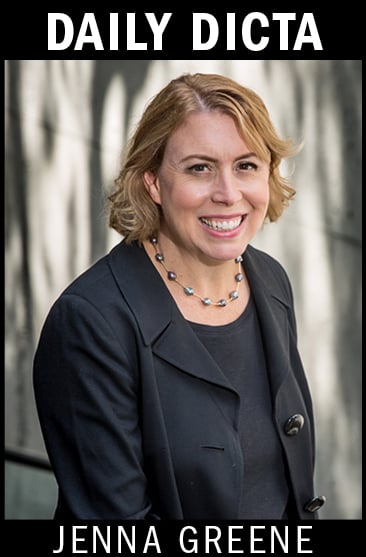Of all the injustices crying out to be righted, slack fill ranks pretty low. But that hasn’t stopped plaintiffs lawyers from bringing a flurry of cases against food and drug companies for under-filling their packaging, leaving empty, non-functional “slack fill” space.
The suits—which, according to a report by the U.S. Chamber Institute for Legal Reform, are proliferating—are premised on a rather unattractive assumption: people are dumb. If a box is big, you’ll automatically think you’re getting more of whatever it is you’re buying, never mind what the label says.
 Sorry, but I have zero sympathy for a grown-up who buys a bottle of Advil that clearly says it contains, say, 48 pills, and then sues because it’s not filled to the brim. A federal judge in New York was right-on to toss that suit last year, handing an easy win to Skadden, Arps, Slate, Meagher & Flom.
Sorry, but I have zero sympathy for a grown-up who buys a bottle of Advil that clearly says it contains, say, 48 pills, and then sues because it’s not filled to the brim. A federal judge in New York was right-on to toss that suit last year, handing an easy win to Skadden, Arps, Slate, Meagher & Flom.
Or take the woman whosued Kentucky Fried Chicken for $20 million because the eight-piece bucket of chicken she bought—while containing eight pieces—was not overflowing with chicken like the one pictured in the ad. Poor KFC is now paying Reed Smith to argue in the Southern District of New York that FDA packaging regulations don’t apply to poultry, that she suffered no injury, and that she could see the contents of the bucket when she bought it, so how could she have been deceived?
But in my mind, the equation changes when we’re talking about candy. Especially the kind that almost no one over age 12 would admit to buying, like Hershey’s Whoppers, Reese’s Pieces, Sour Patch Kids or Swedish Fish.
As a parent, I can attest: kids are easy to fool. They will in fact think they’re getting more candy if the box is bigger. And just because the label says you get 5 ounces of malted milk balls, and there are 18 pieces per serving and 3.5 servings per container, that doesn’t exactly clear things up.
Earlier this month, a federal judge in Missouri refused to dismiss a putative class action against The Hershey Co. over its packaging. The plaintiffs claim that 29 percent of the Reese’s Pieces boxes are slack fill and 41 percent of the Whoppers boxes are nothing but air. This allegedly violates the Missouri Merchandising Practices Act, a broad law covering deceptive or unfair conduct in connection with the sale or advertisement of any product.
While even kids probably don’t expect the Whoppers box to be packed solid with malted milk balls, I don’t think they expect it to be 41 percent empty either.
As George Washington University Law School Professor Jonathan Turley noted, Hershey offered a particularly cringe-worthy defense: the Whoppers and Reese’s Pieces boxes “audibly rattle.” That’s supposed to alert a reasonable consumer that they’re not entirely full.
So an 8-year- old who is spending his entire allowance on a box of candy—agonizing between M&Ms, Mike and Ike’s, and Whoppers, and ultimately picking Whoppers because the box was the biggest—is supposed to gauge the actual milk ball volume by the timbre of the rattle?
I don’t think so.
“In purchasing the products, consumers were denied the benefit of the bargain between what was represented, and what was received,” wrote plaintiffs counsel from Steelman, Gaunt & Horsefield and Kamberlaw LLP in the second amended complaint filed in U.S. District Court for the Western District of Missouri last year. “Consumers would not have purchased the products had they known that the containers were substantially empty, or would have purchased them on different terms.”
Hershey, represented by Steven Zalesin and Michelle Cohen of Patterson Belknap Webb & Tyler and Sonette Magnus of Lewis Rice, responded, “Consumers are well aware of the fact that substantially all commercial packaging contains some empty space.”
Sure, yes. But here’s where they start to stumble. “Any consumer would recognize immediately upon picking up a box of Reese’s Pieces or Whoppers that its contents rattle noticeably and audibly with every movement…In sum, no reasonable consumer could be deceived into believing that the Reese’s Pieces and Whoppers packages are completely full or contain more than the amount of candy disclosed on their respective boxes.”
Really? No reasonable consumer could ever possibly think there were more than 153 Reese’s Pieces in a box? If you thought 154, you’d be a delusional fool?
U.S. District Judge Nanette K. Laughrey pointed out that the lead plaintiff, Robert Bratton, isn’t even arguing that the boxes have to be jam-packed.
“He does not allege that the boxes should be ‘filled to the brim,’ let alone that the packaging is misleading because the contents do not rattle,” she wrote. Rather, it’s “that the boxes are ‘substantially empty,’ have ‘substantial, non-functional slack-fill,’ and have an ‘amount of slack-fill [that] cannot be justified’; that industry-standard machines are capable of filling and enclosing the boxes ‘with far less slack-fill’; and that ‘the level of fill…can certainly be increased.’”
While she kept the case alive with class certification to be determined, other federal courts have tossed similar-sounding complaints at the outset.
For example, U.S. District Judge Colleen McMahon of the Southern District of New York dismissed a slack fill suit over Sour Patch Kids in October 2016.
The plaintiffs, represented by Lee Litigation Group, argued that Sour Patch boxes are oversize and could hold 44 percent more candy than they do.
Sour Patch maker Mondelez International, represented by Jenner & Block, countered that the packaging accurately states the weight and number of candies in the box. Also, they argued that the “slack-fill is necessary to accommodate how the unique watermelon-shaped candies may ‘settle’ in the box, which may lead to more (or less) space being available in the box,” and that the space “protects the contents of the product by preventing the sticky, gummy Sour Patch Kids candies from stacking on top of each other and sticking together.”
That alone wasn’t enough for McMahon to let Mondelez off the hook. But she found the plaintiffs failed to adequately allege an injury. “Plaintiffs have not alleged that they paid a higher price for the candy than they otherwise would have, absent deceptive acts,” she wrote. “Plaintiffs have impermissibly set up the deception as both act and injury.”
Also, it didn’t help that the complaint failed to include exactly where or when the plaintiff bought the candy or how much it cost, and in places referred, inexplicably, to chewing gum. According to Mondelez, this is the fourteenth slack fill class action filed by Lee Litigation Group.
Indeed, the firm has a case pending in the Eastern District of New York over packaging for Swedish Fish gummy candy.
Although in my opinion, half a box of Swedish Fish is more than enough. Sometimes slack fill might be blessing—just ask your dentist.
Contact Jenna Greene at [email protected]. On Twitter @jgreenejenna.



